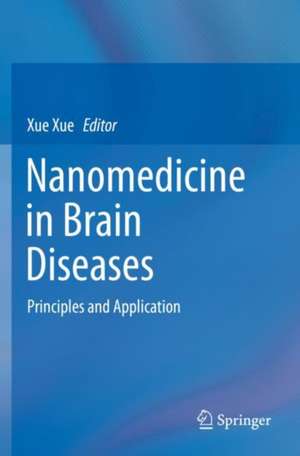Nanomedicine in Brain Diseases: Principles and Application
Editat de Xue Xueen Limba Engleză Paperback – 15 noi 2020
| Toate formatele și edițiile | Preț | Express |
|---|---|---|
| Paperback (1) | 667.81 lei 39-44 zile | |
| Springer Nature Singapore – 15 noi 2020 | 667.81 lei 39-44 zile | |
| Hardback (1) | 682.31 lei 39-44 zile | |
| Springer Nature Singapore – 15 noi 2019 | 682.31 lei 39-44 zile |
Preț: 667.81 lei
Preț vechi: 702.95 lei
-5% Nou
Puncte Express: 1002
Preț estimativ în valută:
127.79€ • 136.65$ • 106.54£
127.79€ • 136.65$ • 106.54£
Carte tipărită la comandă
Livrare economică 14-19 aprilie
Preluare comenzi: 021 569.72.76
Specificații
ISBN-13: 9789811387333
ISBN-10: 9811387338
Pagini: 313
Ilustrații: XIV, 313 p. 103 illus., 91 illus. in color.
Dimensiuni: 155 x 235 mm
Ediția:1st ed. 2019
Editura: Springer Nature Singapore
Colecția Springer
Locul publicării:Singapore, Singapore
ISBN-10: 9811387338
Pagini: 313
Ilustrații: XIV, 313 p. 103 illus., 91 illus. in color.
Dimensiuni: 155 x 235 mm
Ediția:1st ed. 2019
Editura: Springer Nature Singapore
Colecția Springer
Locul publicării:Singapore, Singapore
Cuprins
Introduction: Nanomedicine in the Brain.- The Strategies of Nanomaterials for Traversing Blood-Brain Barrier.- The Strategies of Nanomaterials for Drug Delivery and Release.- The Strategies of Nanomaterials for Therapy.- The Strategies of Nanomaterials for Diagnostic and Imaging.- Nanoenzyme.- Biomacromolecule-Based Nanomedicine.- Carbon-Based Nanomedicine.- Polymeric Nanomedicine.- Magnetic Nanomedicine.- Boron Neutron Capture Nanomedicines.
Notă biografică
Dr. Xue Xue is a professor at the State Key Laboratory of Medicinal Chemical Biology/College of Pharmacy, Nankai University. She received her Ph.D from National Center for Nanoscience and Technology, Chinese Academy of Sciences in 2014. After that, she went to Nathan Kline Institute of Psychiatric Diseases, New York University for further study. She is currently a principle investigator in State Key Laboratory of Medicinal Chemical Biology/College of Pharmacy, and lab chief of Laboratory of Theranostical Nanomedicine in Nankai University. Since 2017, Dr. Xue served as deputy editor of Current Drug Delivery. Her recent achievements are mainly published in the world’s top journals, including Nature Nanotechnology, Molecular Cell, Nano Letters, ACS Nano and Small, etc. In the past few years, she demonstrated the potential bioactivations of carbon nanotube for reversing autophagy defects in Alzheimer's disease and preventing drug addiction in methylamphetamine. Her research interests include: 1. The design and development of novel nanomedicine and its clinical application; 2. The bioactivity, structure-activity relationship, safety and mechanism of nanomedicine; 3. The intrinsic properties of nanomaterials in the treatment of neuropsychiatric diseases and their mechanism; 4. The development of nanomaterials in early diagnosis in neuropsychiatric diseases.
Textul de pe ultima copertă
This book provides an overview of the current applications of nanomaterials in brain diseases, and introduces several novel nanomaterials that have excellent potential in this field. During the last two decades, nanotechnology had matured significantly as it has transitioned from a bench-top science to an applied technology. However, the application of nanomaterials in basic and clinical neuroscience is still at an early stage, and understanding how the intrinsic properties of nanomaterials translate to complex biological responses is an area of intensive research. Part 1 of the book focuses on the principles and strategies of nanomedicine in the brain diseases, while part 2 examines the applications of promising nanomaterials for therapy and diagnosis in the brain. Together they offer a comprehensive picture of advances in nanotechnology and their successful use in treating brain diseases in the past 20 years.
Caracteristici
Broadens your understanding of nanomedicine Thoroughly examines the principles and strategies of nanomedicine for brain diseases Includes case studies that illustrate the application of nanotechnology in treating brain diseases
